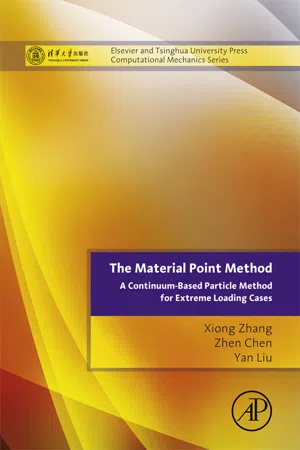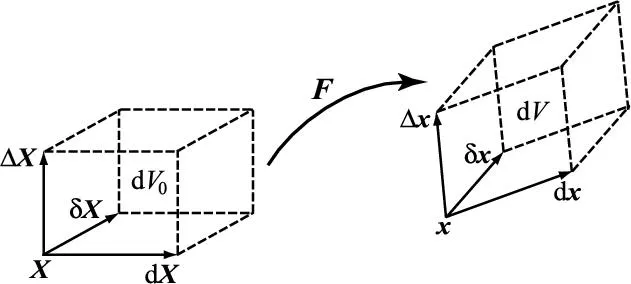
eBook - ePub
The Material Point Method
A Continuum-Based Particle Method for Extreme Loading Cases
- 300 pages
- English
- ePUB (mobile friendly)
- Available on iOS & Android
eBook - ePub
The Material Point Method
A Continuum-Based Particle Method for Extreme Loading Cases
About this book
The Material Point Method: A Continuum-Based Particle Method for Extreme Loading Cases systematically introduces the theory, code design, and application of the material point method, covering subjects such as the spatial and temporal discretization of MPM, frequently-used strength models and equations of state of materials, contact algorithms in MPM, adaptive MPM, the hybrid/coupled material point finite element method, object-oriented programming of MPM, and the application of MPM in impact, explosion, and metal forming.
Recent progresses are also stated in this monograph, including improvement of efficiency, memory storage, coupling/combination with the finite element method, the contact algorithm, and their application to problems.
- Provides a user's guide and several numerical examples of the MPM3D-F90 code that can be downloaded from a website
- Presents models that describe different types of material behaviors, with a focus on extreme events.
- Includes applications of MPM and its extensions in extreme events, such as transient crack propagation, impact/penetration, blast, fluid-structure interaction, and biomechanical responses to extreme loading
Frequently asked questions
Yes, you can cancel anytime from the Subscription tab in your account settings on the Perlego website. Your subscription will stay active until the end of your current billing period. Learn how to cancel your subscription.
At the moment all of our mobile-responsive ePub books are available to download via the app. Most of our PDFs are also available to download and we're working on making the final remaining ones downloadable now. Learn more here.
Perlego offers two plans: Essential and Complete
- Essential is ideal for learners and professionals who enjoy exploring a wide range of subjects. Access the Essential Library with 800,000+ trusted titles and best-sellers across business, personal growth, and the humanities. Includes unlimited reading time and Standard Read Aloud voice.
- Complete: Perfect for advanced learners and researchers needing full, unrestricted access. Unlock 1.4M+ books across hundreds of subjects, including academic and specialized titles. The Complete Plan also includes advanced features like Premium Read Aloud and Research Assistant.
We are an online textbook subscription service, where you can get access to an entire online library for less than the price of a single book per month. With over 1 million books across 1000+ topics, we’ve got you covered! Learn more here.
Look out for the read-aloud symbol on your next book to see if you can listen to it. The read-aloud tool reads text aloud for you, highlighting the text as it is being read. You can pause it, speed it up and slow it down. Learn more here.
Yes! You can use the Perlego app on both iOS or Android devices to read anytime, anywhere — even offline. Perfect for commutes or when you’re on the go.
Please note we cannot support devices running on iOS 13 and Android 7 or earlier. Learn more about using the app.
Please note we cannot support devices running on iOS 13 and Android 7 or earlier. Learn more about using the app.
Yes, you can access The Material Point Method by Xiong Zhang,Zhen Chen,Yan Liu in PDF and/or ePUB format, as well as other popular books in Technology & Engineering & Computer Engineering. We have over one million books available in our catalogue for you to explore.
Information
Chapter 1
Introduction
Abstract
Based on the way how deformation and motion are described, existing spatial discretization methods can be classified into Lagrangian, Eulerian and hybrid ones, respectively. Chapter 1 briefly introduces the basic ideas and features of the Lagrangian method, Eulerian method, Arbitrary Lagrangian–Eulerian method, Particle-In-Cell method, and meshfree methods, respectively.
Keywords
Lagrangian method; Eulerian method; Arbitrary Lagrangian–Eulerian method; Particle-in-cell method; Material point method; Meshfree methods
Simulation-based Engineering Science (SBES) [2] is the third pillar of the modern science and engineering, a peer alongside theory and physical experiment [1]. Compared with physical experiment, SBES has the advantages of low cost, safety, and efficiency in solving various kinds of challenging problems. To better simulate those extreme events such as hypervelocity impact, penetration, blast, crack propagation, and multi-phase (solid–liquid–gas) interactions involving failure evolution, yet effectively discretize localized large deformation, the transition among different types of failure modes and fragmentation remains a very difficult task. Based on the way how deformation and motion are described, existing spatial discretization methods can be classified into Lagrangian, Eulerian, and hybrid ones, respectively.
1.1 Lagrangian Methods
In Lagrangian methods the computational grid is embedded and deformed with the material. Since there is no advection between the grid and material, no advection term appears in the governing equations, which significantly simplifies the solution process. The mass of each material element keeps constant during the solution process, but the element volume varies due to element deformation. Lagrangian methods have the following advantages:
1. They are conceptually more simple and efficient than Eulerian methods. Because there is no advection term that describes the mass flow across element boundaries, the conservation equations for mass, momentum, and energy are simple in form, and can be efficiently solved.
2. Element boundaries coincide with the material interfaces during the solution process so that it is easy to impose boundary conditions and to track material interfaces.
3. Since Lagrangian methods track the flow of individual masses, it is easy to implement history-dependent constitutive models.
Fig. 1.1 shows a typical Lagrangian grid which is embedded and deformed with the material. Severe element distortion results in significant errors in numerical solution, and even leads to a negative element volume or area which would cause abnormal termination of the computation. To obtain a stable solution with an explicit time integration scheme, the time step must be smaller than a critical time step which is controlled by the minimum characteristic length of all elements in the grid. Because severe element distortion would significantly decrease the characteristic element length, the time step in a Lagrangian calculation could become smaller and smaller, and finally approach zero, which makes the computation impossible to be completed. To complete a Lagrangian computation for an extreme loading case, a distorted grid must be remeshed and its result must be interpolated to the remeshed grid. The remesh or rezone technique has been successfully used in solving many 1D and 2D problems, but rezoning a complicated 3D material domain is still a challenging task. For a history-dependent material, the history variables are also required to be interpolated from the old grid to the new grid, which may further cause numerical error in stress calculation.

Figure 1.1 Lagrangian grid.
Another way to eliminate the element distortion is to use the erosion technique, which simply deletes the heavily distorted elements. An element is considered to be heavily distorted if its equivalent plastic strain exceeds a user-defined erosion strain value, or the critical time step size is less than a prescribed value. Introducing element erosion can resolve some of the issues related to the severe element distortion, but also introduce new issues. The global system will lose both mass and energy, which can severely affect the simulation outcome. Furthermore, the erosion technique cannot model the formation process of debris cloud and its interaction with other panels in hypervelocity impact simulation.
Many Lagrangian codes have been developed, as shown in the open literature. The HEMP [8] was developed in the early 1960s by Wilkins at the Lawrence Livermore National Laboratory. The HEMP was an explicit Lagrangian finite-difference code that could handle large strains, elastic–plastic flow, wave propagation, and sliding interfaces. The EPIC code [9] was an explicit Lagrangian finite element code developed in the 1970s by Johnson. Both the rezoning and erosion techniques were employed in the EPIC to simulate high velocity impact and blast problems. The PRONTO3D code [10] was a 3D transient solid dynamics code developed at the Sandia National Laboratory for analyzing large deformations of highly nonlinear materials subjected to extremely high strain rates. This code was based on an explicit finite element formulation, and had been coupled with the smoothed particle hydrodynamics (SPH) method through a contact-like algorithm [11]. The DYNA2D and DYNA3D codes were developed in the 1970s at the Lawrence Livermore National Laboratory as explicit Lagrangian finite element codes and were successfully commercialized [12–14].
1.2 Eulerian Methods
For problems in which a material domain could become heavily distorted or different materials are mixed, an Eulerian method is more appropriate. In Eulerian methods, the computational grid is fixed in space and does not move with the material such that the material flows through the grid, as shown in Fig. 1.2.

Figure 1.2 Eulerian grid.
There is no element distortion in Eulerian methods, but the physical variables, such as mass, momentum, and energy, advect between adjacent elements across their interface. The volume of each element keeps constant during the simulation, but its density varies due to the advection of mass. Eulerian methods are suited for modeling large deformations of materials so that most of computational fluid dynamics codes and early hydrocodes for impact and blast simulation employ Eulerian methods.
Eulerian methods only calculate the material quantities advected between elements without explicitly and accurately determining the position of material interface and free surface so that they are quite awkward in following deforming material interfaces and moving boundaries. Significant efforts have been made to develop interface reconstruction methods.
HELP (Hydrodynamic plus ELastic Plastic) [15], developed by Walsh and Hageman in the 1960s, is a multi-material Eulerian finite difference program for compressible fluid and elastic–plastic flows. To treat the material interface or free surface, massless tracer particles are used, which define the surface position and move across the Eulerian grid. CTH [16] is an Eulerian finite volume code developed at Sandia National Laboratories to model multi-dimensional, multi-material, large deformation, and strong shock wave physics. The CTH code employs a two-step Eulerian solution scheme, a Lagrangian step in which the cells distort to follow the material motion, and a remesh step where the distorted cells are mapped back to the Eulerian mesh. Material interfaces are reconstructed using the Sandia Modified Young's Reconstruction Algorithm. The CTH has adaptive mesh refinement and uses second-order accurate numerical methods to reduce numerical dispersion and dissipation. It is still under development at Sandia National Laboratories [17].
The Zapotec developed at Sandia National Laboratories is a framework that tightly couples the CTH and PRONTO codes [18,19]. In a Zapotec analysis, both CTH and PRONTO are run concurrently. For a given time step, the Zapotec maps the current configuration of a Lagrangian body onto the fixed Eulerian mesh. Any overlapping Lagrangian material is inserted into the Eulerian mesh with the updated mesh data passed back to the CTH. After that the external loading on the Lagrangian material surfaces is determined from the stress state in the Eulerian mesh. These loads are passed back to PRONTO as a set of external nodal forces. After the coupled treatment is completed, both CTH and PRONTO are run independently over the next time step.
1.3 Hybrid Methods
Both purely Lagrangian and purely Eulerian methods possess different shortcomings and advantages so that it is desirable to find new approaches to take advantage of bot...
Table of contents
- Cover image
- Title page
- Table of Contents
- Copyright
- Dedication
- About the Authors
- Preface
- Chapter 1: Introduction
- Chapter 2: Governing Equations
- Chapter 3: The Material Point Method
- Chapter 4: Computer Implementation of the MPM
- Chapter 5: Coupling of the MPM with FEM
- Chapter 6: Constitutive Models
- Chapter 7: Multiscale MPM
- Chapter 8: Applications of the MPM
- Bibliography
- Index